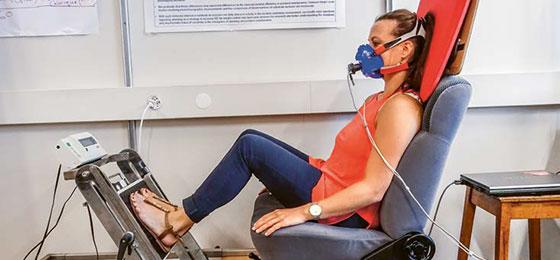Small steps in fighting fat

Many people spend the greater part of their day sitting down. Researchers at the University of Fribourg are investigating how many calories we could burn if we were to stand instead. By Florian Fisch
(From "Horizons" no. 114 September 2017)
In Switzerland, almost two-thirds of adults are overweight, despite broad-based campaigns to counter it. And the trend is upwards. This also means an increased risk of cardiovascular diseases, type 2 diabetes mellitus, and even several types of cancer. Many people try to burn off excess calories by doing sports.
But the majority of our less athletic fellow citizens can also get their weight under control by moving more. In order to help them, a group led by Abdul Dulloo, a professor of nutritional physiology at the University of Fribourg, is studying the energy expended during normal activities. "Up to now, most studies have concentrated on intensive activities that require roughly five to 12 times as much energy as lying down or sitting. But in everyday life, we rarely go above four times that level of intensity".
His team's experiments (see the box 'Measuring energy consumption') show that by just standing, we use on average ten percent more energy than when we sit. But they also found that standing only boosts energy consumption to any considerable extent in one out of four people. "In all the activities we've measured, people consume very different amounts of energy", explains Dulloo. And this can't be explained away just by their age or weight. Even obese people display very different degrees of energy consumption.
The goal of individualised prevention
The researchers tried to find the answers in the different ways people stand. Do people use up more energy when they repeatedly shift their weight from one leg to the other? The answer is disappointingly no. So this also couldn't explain the differences between individuals. "In order to burn more calories properly, people have to take whole steps", says Dulloo. Once he and his team have understood these small differences, he hopes that they will be able to individualise strategies to counter excess weight.
It is still difficult to reach the right people with national health campaigns, says Sigrid Beer from the Institute of Social and Preventive Medicine at the University of Bern. "Preventive measures have to reach both those members of the population who are not yet affected, and also those who are as yet unaware of the problem". Only once someone is under treatment today do they start to consider changes to their individual behaviour.
If the wrong people go on diets, this could even trigger an increase in weight later on. If people of normal weight reduce their lean body mass, the body counteracts by saving energy and by increasing its energy intake, says Dulloo. It also reduces the level of the hormone leptin, which regulates fat metabolism and indirectly holds back our appetite.
At the same time, more and more people are spending eight hours a day sitting in front of their computer screens. "We are experiencing an erosion of our daily physical activity. So we try to compensate by doing sports. But it's not enough to jog a little and then sit around the whole day", says Dulloo.
Florian Fisch is a science editor at the SNSF.
J. L. Miles-Chan et al.: Standing economy: does the heterogeneity in the energy cost of posture maintenance reside in differential patterns of spontaneous weight-shifting? European Journal of Applied Physiology (2017)
A. G. Dulloo: Collateral fattening: When a deficit in lean body mass drives overeating. Obesity (2017)
Measuring energy consumption
Abdul Dulloo of the University of Fribourg is measuring the energy consumption of low-level activities. Instead of having his test subjects run on a conveyor belt, he has them stand and shift their weight from one leg to the other, and uses two sets of scales to find out how vigorously they shift their weight. Or he has them cycle on an ergometer with low pedal resistance. In another test, they have to sit down and press their feet against a plank every 30 seconds.
Their oxygen use can be measured using a mask or hood, and this enables Dulloo to calculate their metabolic rate. The relationship between the amount of oxygen they inhale and the amount of carbon dioxide they exhale can even allow him to draw conclusions about the substrates used up – whether more fat or carbohydrates. His test subjects also swallow a thermometer in the form of a pill the size of a thumbnail, and this transmits the temperature in the digestive tract to an external receiver once every minute.